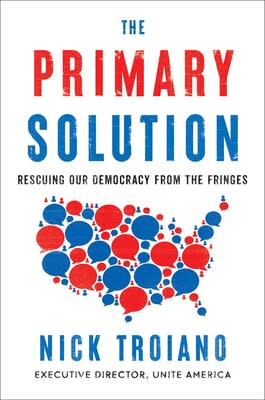How a bipartisan governing majority emerged in Alaska

- Oops!Something went wrong.Please try again later.
Senate Majority Leader Cathy Giessel on Jan. 6, 2023, at Alyeska Resort. (Photo by Yereth Rosen/Alaska Beacon)
This is an excerpt from the book “The Primary Solution,” published by Simon & Schuster in February.
Republican state Senate President Cathy Giessel was not a supporter of Ballot Measure 2 in 2020. “I was totally against it. I spoke to community groups about how this would be awful,” she told me when we met for coffee in Anchorage. “I was worried that conservative voices would be drowned out.”

At the same time, Giessel regularly worked across the aisle to make progress on issues important to Alaska. She was a strong fiscal conservative. Rather than dip into the state’s savings or raise new taxes, she supported cutting back the state’s Permanent Fund dividend (the check every Alaskan receives from the government) in order to fund basic government services. She worked with the Democratic minority leader in the Senate and the independent speaker of the state House to pass a responsible budget—bringing along a majority of Republicans, but marginalizing a far-right faction in her own party’s caucus. That, of course, was a recipe for being primaried.
“I’ve worked in the Republican Party for decades as a precinct committee woman, a district chair, even the statewide vice chair of the party. I was Republican Woman of the Year several times. But at the district convention in 2020, I was laughed at and booed off the stage,” she recalled. Republican Party leaders proactively recruited challengers in several legislative districts where members were not toeing the party line, including Giessel’s. “I was getting yelled at while door knocking, ‘You stole my dividend and you worked with the Democrats to do that. Get off my property. I have guns.’ . . . It was frightening and shocking.”
In the August 2020 elections, seven GOP incumbents were primaried out of office, including Giessel. A political newcomer named Roger Holland defeated her, 64% to 36%, by claiming she had lost touch with “what her job should be as a Republican senator in a Republican state with Republican majorities in the House and Senate and a Republican governor.” The experience was devastating, causing her to reevaluate her position on the reform ballot measure. “I looked at it more and more. I began to realize there’s too much hostility here. We’re just too divided. We’ve got to start working together. So by the time we actually voted on that initiative, I had moved to support it.”
Two years later, Giessel ran again for her old seat and, under the new top-four nonpartisan primary, found it completely changed the way she campaigned. In the past, like most candidates, Giessel would purchase a voter list from a party-affiliated vendor that would tell her what doors to knock on in her district for the primary election. Using a sophisticated data analysis, the list would provide each household a rating based on their likely partisanship and likelihood to vote—saving candidates time by only talking to the voters who could vote in the primary and who were likely to support them.
This time around, since every voter could participate in the primary and vote for whichever candidate they desired, Giessel didn’t even purchase a list. “I just went to every single door and it was delightful. I was knocking on doors I walked past in the past and having great conversations with incredible people of such diversity. It was just a breath of fresh air to find the common themes,” she said. “It also required me to be much more authentic in how I answered a question from a voter, because I didn’t know whose door I was knocking, much less what groups they belong to or what their party affiliation is.” Giessel was the top finisher in her three-way primary, earning 36% of the vote.
All three candidates—including the incumbent Republican who primaried her in 2020 and a Democrat—advanced to the general election. She continued to knock on every door. In the general election, voters had the option of ranking their candidates rather than choosing only one. Giessel used this to her advantage to build a broad base of support. For example, on one door, she encountered a Republican who preferred the incumbent over her. “So I’d say, ‘That’s fine. But you get a second choice, so I’d appreciate it if you would rank the red,’” she explained, referring to ranking all of the GOP candidates. On another door, she encountered a voter who remembered her from her prior terms. “He looks at me and he goes, ‘Oh, you’ve knocked on the wrong door. I’m a Democrat.’ And I said, ‘No, sir, you’re exactly the person I want to talk to.’ And so we had a great conversation.” She explained that he could rank her second in case the Democrat doesn’t win. In November, Giessel won 33.8%, the Republican incumbent 33.1%, and the Democrat 33%. In the instant run-off tabulation, the Democrat was eliminated, and Giessel prevailed with 57%. No longer could a minority of voters in one party’s primary block the will of the majority of voters in her district.
By the time the new Legislature gaveled into session, the Senate was no longer organized into a majority party and a minority party. Instead, in the body of twenty, eight Republicans and nine Democrats decided to form a bipartisan caucus; Giessel was named majority leader. Rather than the three far-right Republicans exercising disproportionate control over the majority party, they were ostracized into a caucus of their own. (Such legislative coalitions are not uncommon in Alaska, though it had been a decade since the last coalition in the Senate.) The bipartisan coalition put divisive social issues to the side. “We decided we’re going to stay on the ideas that we can find agreement on—which is the economy, public safety, education and a balanced budget. It’s just been delightful,” she said. For the first time in five years, the Legislature passed a budget without needing to go into an extended special session.
Having to run a different kind of campaign was profoundly impactful on Giessel once in office. “I had really gotten to be more education oriented,” she said. She homeschooled her three kids and her husband taught in a private school for 14 years. “I had come from a different perspective, but there were families whose door I would knock on and I’d hear from the parents about how critical the schools are for them and their kids. It helped me see the value of just having the schools open and a safe place where kids can go and know there’ll be food there. The state budget included the largest increase in public education funding in the state’s history. “That explosive revelation going door-to-door that there were all the things in the middle gave me a lot more freedom in this last session to go, you know, I could vote for that. This is what my constituents want.”
Correction: The numbers of Republicans and Democrats in the Senate majority were transposed in the original version of this article.
GET THE MORNING HEADLINES DELIVERED TO YOUR INBOX
The post How a bipartisan governing majority emerged in Alaska appeared first on Alaska Beacon.

